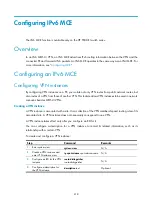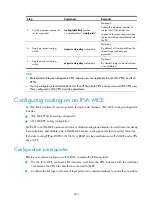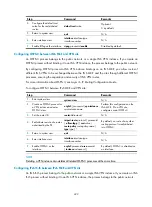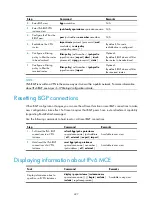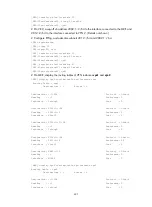
427
Step Command
Remarks
2.
Enter BGP view.
bgp
as-number
N/A
3.
Enter IPv6 BGP-VPN
instance view.
ipv6-family vpn-instance
vpn-instance-name
N/A
4.
Configure the PE as the
EBGP peer.
peer
ipv6-address
as-number
as-number
N/A
5.
Redistribute the VPN
routes.
import-route
protocol
[
process-id
[
med
med-value
|
route-policy
route-policy-name
] * ]
By default, No route
redistribution is configured.
6.
Configure a filtering
policy to filter the routes
to be advertised.
filter-policy
{
acl6-number
|
ipv6-prefix
ip-prefix-name
}
export
[
direct
|
isisv6
process-id
|
ripng
process-id
|
static
]
Optional.
By default, BGP does not filter
the routes to be advertised.
7.
Configure a filtering
policy to filter the
received routes.
filter-policy
{
acl6-number
|
ipv6-prefix
ip-prefix-name
}
import
Optional.
By default, BGP does not filter
the received routes.
NOTE:
IPv6 BGP runs within a VPN in the same way as it runs within a public network. For more information
about IPv6 BGP, see
Layer 3—IP Routing Configuration Guide.
Resetting BGP connections
When BGP configuration changes, you can use the soft reset function or reset BGP connections to make
new configurations take effect. Soft reset requires that BGP peers have route refreshment capability
(supporting Route-Refresh messages).
Use the following commands to hard reset or soft reset BGP connections:
Step Command
Remarks
1.
Soft reset the IPv6 BGP
connections in a VPN
instance.
refresh bgp ipv6 vpn-instance
vpn-instance-name
{
ipv6-address
|
all
|
external
} {
export
|
import
}
Available in user view
2.
Hard reset the IPv6 BGP
connections of a VPN
instance.
reset bgp ipv6 vpn-instance
vpn-instance-name
{
as-number
|
ipv6-address
|
all
|
external
}
Available in user view
Displaying information about IPv6 MCE
Task Command Remarks
Display information about a
specific or all VPN instances.
display ip vpn-instance
[
instance-name
vpn-instance-name
] [
|
{
begin
|
exclude
|
include
}
regular-expression
]
Available in any view






